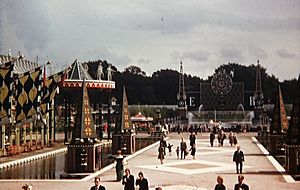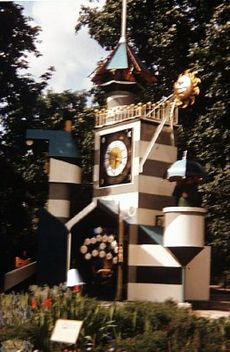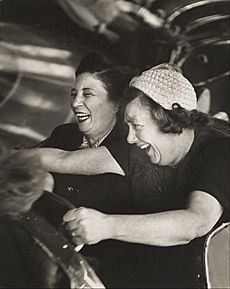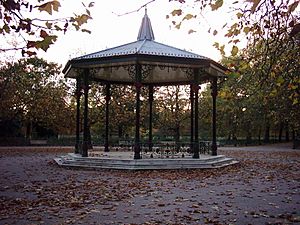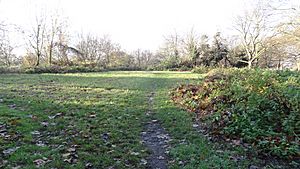Battersea Park facts for kids
Quick facts for kids Battersea Park |
|
|---|---|
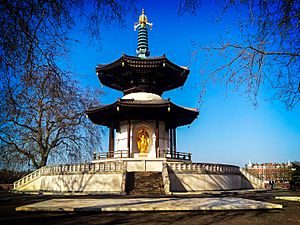 |
|
| Lua error in Module:Location_map at line 420: attempt to index field 'wikibase' (a nil value). | |
| Location | Battersea London, SW11 United Kingdom |
| Area | 200 acres (81 ha) (0.8 km²) |
| Created | 1858 |
| Operated by | Wandsworth Council |
| Public transit access | |
Battersea Park is a large green space in Battersea, London. It covers about 200 acres (83 hectares). The park sits on the south side of the River Thames, across from Chelsea. It first opened its gates in 1858.
This park was created on land that used to be marshy. This land was reclaimed from the River Thames. Before that, it was used for growing vegetables for market.
Battersea Park is very important historically. It is listed on the Register of Historic Parks and Gardens.
Contents
Discovering Battersea Park's Past
Before 1846, the area was known as Battersea Fields. It was a popular spot for duelling. A duel was a formal fight between two people. They would use weapons to settle disagreements. On March 21, 1829, the Duke of Wellington and the Earl of Winchilsea met here. They were there to settle an argument about their honour. The Duke fired his pistol away from the Earl. The Earl fired his into the air. The Earl later apologized to the Duke.
The fields were low and fertile. They had streams and ditches. Farmers grew carrots, melons, and lavender here. They also grew famous "Battersea Bunches" of asparagus.
Along the river, there were factories and docks. These included a pottery and chemical works. Railways were also starting to appear.
How the Park Was Created
In 1845, people decided to create a royal park. This idea came from the local vicar and a builder named Thomas Cubitt. His building yards were across the river. A law was passed in 1846 to create the park. The government promised £200,000 to buy the land.
They bought 320 acres of Battersea Fields. About 198 acres became Battersea Park. It officially opened in 1858. The rest of the land was rented out for building.
Sir James Pennethorne designed the park. He worked on it from 1846 to 1864. The park that opened in 1858 was a bit different from his first plans.
The park's success depended on the new Chelsea Bridge. Queen Victoria opened the bridge in 1858. Roads around the park were named in her honour. These included Victoria Road and Queens Road. Prince of Wales Road was built along the south side. Albert Bridge Road was built on the west side. In 1889, the London County Council took over managing the park.
Early Football Games
Battersea Park has a special place in football history. On January 9, 1864, it hosted the first exhibition football game. This game followed the new rules of The Football Association. Famous footballers of the time played in this match.
From the 1860s, the park was home to Wanderers F.C.. This was a top amateur football team. They won the first FA Cup in 1872. The park also hosted the historic London v Sheffield football match in March 1866.
War Memorial and Wartime Role
In 1924, a war memorial was unveiled. It was designed by Eric Kennington. This memorial remembers over 10,000 men. They were killed or went missing while serving in the 24th East Surrey Division. This memorial is now also a Grade II* listed building.
During both World Wars, the park helped protect London. Anti-aircraft guns and barrage balloons were set up. Shelters were dug for safety. Parts of the park were used to grow vegetables. A pig farm was also started. Park maintenance was reduced to help the war effort.
The Festival Gardens and Fun Fair
In 1951, the northern part of the park changed a lot. It became the "Pleasure Gardens" for the Festival of Britain. New features included water gardens and fountains. There was also a "Tree-Walk." This was a series of raised wooden walkways. They connected platforms like tree houses in the trees.
Popular attractions included the Guinness Clock. It was designed by Jan Le Witt and George Him. Another fun ride was the Far Tottering and Oyster Creek Branch Railway.
Battersea Fun Fair
The Battersea Fun Fair was another new addition. It had roller coasters, swings, and other rides.
The most exciting ride was a wooden roller coaster. It was called The Big Dipper. It opened in 1951. In 1970, it had a big fire. On May 30, 1972, it closed for good. One of the trains rolled backward and crashed. This happened because a safety part failed. Without its main attraction, the funfair became less popular. It closed completely in 1974.
After the funfair closed, one ride, the "Jetstream," was sold. It went to Belle Vue Zoological Gardens in Manchester.
The funfair also appeared on TV. A spooky, empty scene of the funfair was in the opening of the 1960s show Journey to the Unknown.
What You Can See and Do Today
The area where the funfair used to be is now flat. It hosts traveling fairs and events. It is home to Battersea Evolution. This venue hosts exhibitions, conferences, and parties.
The park has many fun things to do. There is a small children's zoo. You can also find a boating lake and a bandstand. There are outdoor sports facilities too. These include tennis courts, a running track, and football pitches. Four West London hockey teams use the Astroturf pitches.
In the middle of the park is Pump House Gallery. It is inside a four-story Victorian tower. This tower is a Grade I listed building. Wandsworth Council owns the gallery.
On the west side, there are two cricket pitches. They are home to the King's Road Cricket & Social Club. You can see their members playing on Saturdays and Sundays. They wear bright orange caps.
The park is also home to the London Peace Pagoda. It was built in 1985. A Buddhist monk cares for the pagoda every day. A statue of a dog is also in the park. It is a copy of a famous bronze statue. This original statue was part of the historic Brown Dog affair. The replica was put here in 1985. In 1994, it moved to the Woodland Walk. This is near the Old English Garden.
From 2002 to 2004, the park was refurbished. This cost £11 million. The Heritage Lottery Fund helped pay for it. Prince Philip reopened the park on June 2, 2004.
In 2007, a Dog Walk of Fame opened in the park.
The Winter Garden is next to Albert Bridge Road. The Friends of Battersea Park asked for it to be built. Dan Pearson Studios designed it. Mayor Boris Johnson opened it on March 3, 2011. He also unveiled a special plaque.
In 2011, a sculpture called After 9/11 was unveiled. It remembers the 10th anniversary of the 9/11 terror attacks.
In 2012, the park hosted a Foodies Festival. This happened from August 17 to 19. Chefs like Levi Roots gave cooking classes. There were also burlesque shows, restaurant tents, and outdoor cinemas.
Battersea Park Nature Areas
A small strip along the park's eastern edge is special. Two other small areas nearby are also special. They are called the Battersea Park Nature Areas. They are a Local Nature Reserve. These areas cover three hectares. Many woodland birds live here. These include blackcap and bullfinch. There are also 20 types of butterflies. Several kinds of stag beetles live here too. Other insects include the hoverfly Volucella zonaria.
Battersea Park in Arts and Media
The park has appeared in many songs, films, and TV shows.
Petula Clark's 1954 song "Meet Me in Battersea Park" is about the park. Her father helped write the song. It was also the title of a music collection in 2001.
The park was in 1960s films like Gorgo and The Wrong Arm of the Law. It also appeared in The Day the Earth Caught Fire. An episode of Mr. Bean in 1991, "Mr Bean Goes to Town," featured the park. Jim Henson's company filmed a musical scene here for "The Great Muppet Caper."
On September 16, 1978, Battersea Park hosted a big punk rock concert. The Stranglers performed. Other guests included Peter Gabriel and The Skids.
The cafe and bandstand were in the 1998 British comedy Martha, Meet Frank, Daniel and Laurence.
The first 50 seconds of One Direction's music video for "One Thing" were filmed here. They used the old Festival Gardens area.
British artist Marion Coutts made an art piece called Fresh Air. It had unusual ping-pong tables. They looked like Battersea Park, Regent's Park, and Hyde Park.
Nearby Railway Stations
- Battersea Park
- Queenstown Road (Battersea)
- Closed Stations
- Battersea Park Road
- Pimlico
Images for kids




